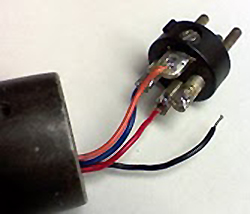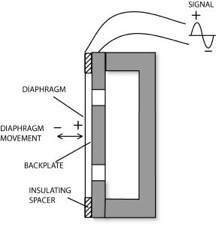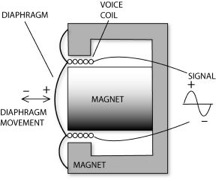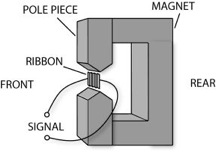
Why Condenser Mics Need Powering
Let’s explain why condenser mics need power in order to operate.
In a condenser microphone transducer (Figure 2), a conductive diaphragm and an adjacent metallic disk (backplate) are charged with static electricity to form two plates of a capacitor.
When sound waves strike the diaphragm, they vary the spacing between the plates. This varies the capacitance and generates an electrical signal similar to the incoming sound wave.
The diaphragm and backplate can be charged in two ways:
1. By an externally applied voltage (from phantom power). This arrangement is called “external bias” or “true condenser”.
2. By a permanently charged electret material in the diaphragm or on the backplate. This is called “internal bias” or “electret condenser”.
The output of the condenser mic capsule is extremely high impedance so it is very hum-sensitive.
To bring that impedance down to a usable value, an impedance-converter circuit is connected to the capsule output.
This circuit is necessary whether the capsule is electret or non-electret. The converter needs a DC voltage to power it, and this voltage is supplied by the phantom power supply. Sometimes other transistors are added to give the mic a balanced output, and these components work off phantom power too.
In contrast, a dynamic microphone needs no power because it has no active electronics. It generates its own electricity like a loudspeaker in reverse. In a moving-coil dynamic microphone (Figure 3), a coil of wire is attached to a diaphragm.
This voice coil is suspended in a magnetic field. When sound waves vibrate the diaphragm and its attached coil, the coil vibrates in the magnetic field and generates an electrical signal similar to the incoming sound wave. The voice-coil leads are soldered to XLR pins 2 and 3 inside the microphone.
In a ribbon microphone (Figure 4), the diaphragm is a thin metal foil or ribbon. Sound waves vibrate the ribbon in a magnetic field and generate corresponding electrical signals. The ribbon leads are soldered to XLR pins 2 and 3 inside the microphone.
You can plug a dynamic or ribbon microphone into a phantom supply without damaging the mic. That’s because the voice-coil or ribbon leads are not connected to pin 1, so no current from the phantom supply can flow through them.
However, if there’s any imbalance in the phantom voltage applied to pins 2 and 3, a current will flow through the microphone voice coil or ribbon (which is connected to pins 2 and 3).
Or if one terminal of the coil or ribbon is accidentally shorted to the grounded mic housing, a current will flow through the coil or ribbon. For this reason, it’s best to switch off phantom power for dynamic and ribbon mics.



